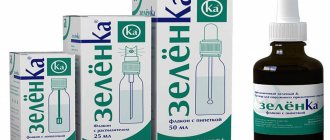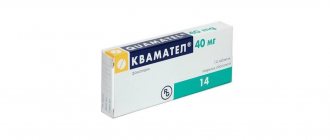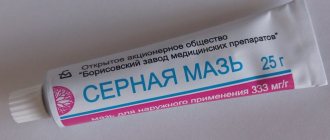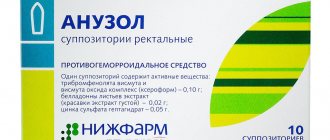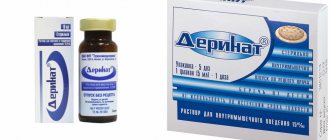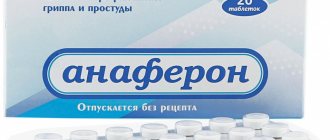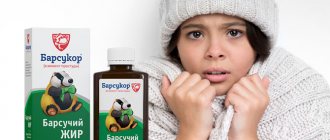Zelenka ( Brilliant green solution ), popularly called, is an antiseptic and must be present in home first aid kits.
This powerful antifungal and antibacterial agent is used to treat the skin of the body.
The solution has a deep emerald color and has been used in the medical industry for several decades.
Composition of brilliant green
The basis of brilliant green is an alcohol solution, which is obtained exclusively synthetically.
The composition of this popular product:
- Brilliant green – 1 gram per 100 g.
- Ethyl alcohol - about 99-100 ml, or approximately 60% per 100 g.
The composition of the product depends on its form of release for sale. The most famous type is an alcohol solution, produced in bottles of 10-15 ml.
The product can be used for two years after release.
In modern pharmacology, a diamond marker and a special dry powder have also been invented.
If necessary, the prepared powder is diluted with plain water before use in an acceptable concentration of the drug from 0.1% to 2%.
A marker soaked in this solution is the most convenient form and is used to treat small wounds, scars and emerging pimples.
The marker allows you to do without the usual cotton wool, does not stain your hands and is a product that is very convenient to use.
Also today, the product is available in the form of sprays or in small bottles with a pipette, which ensures ease of use.
Interesting! Previously, doctors used dyes for their work purposes. Various preparations were stained using these means to better examine the life of microorganisms under a microscope. Suddenly, doctors discovered that brilliant green dye destroys microbes with high efficiency. Since then, this effective antiseptic began to be confidently used in everyday medical practice, and even today it is in no hurry to give way to analogues.
Composition of Zelenka and pharmacological action
The brilliant green is based on a solution of brilliant green. This is an antiseptic substance that was developed by a British scientist. In his attempts to discover a cure for malaria, he was able to create substances with bright colors. At first these were purple and lilac solutions that were not removed from fabrics and other surfaces.
Doctors began to use this feature of giving color to substances to color reagents and microorganisms during microscopic studies. During this application, it turned out that microbes die under the influence of a brilliant green solution. This is how the antiseptic properties of brilliant green were discovered.
What is greenery used for?
The main use of the brilliant green solution is to treat wounds and shallow cuts, small scratches, bruises or cuts at home.
With the help of such a product, microbes that have entered the resulting wound are almost instantly eliminated, and it also has an anti-inflammatory effect, which leads to rapid healing of the skin.
Zelenka is widely used for quick treatment of postoperative sutures and post-traumatic scars on the surface of the body.
This has a disinfecting effect and stimulates the rapid process of skin regeneration.
In newborn babies, the umbilical wound, small pimples and diaper rash are treated with this product, which provides easy drying.
Often brilliant green is used as an effective adjuvant for the treatment of the following skin problems:
- furunculosis;
- infectious inflammation of the eyelids;
- Staphylococcus aureus;
- carbunculosis;
- the appearance of internal stye and various infectious eye diseases.
For eye problems, carefully lubricate the eyelids with the solution, because if this drug gets into the eyes, it leads to a sharp burning sensation and severe tearing.
The solution is also suitable for application to the bite sites of blood-sucking insects and relieves irritating itching on the skin after contact with them.
Important! The layer of the drug on the wound is necessarily refreshed as it dries and is gradually absorbed. The applied product remains active for approximately 24 hours.
In what cases does brilliant green help?
It is noteworthy that the tradition of “treating” chickenpox with brilliant green is actually practically meaningless - the remedy only dries out the wounds and helps control the occurrence of new rashes (the end of the appearance of which will indicate the approach of recovery), but the drug is powerless against the causative agent of the disease itself.
Not so long ago, brilliant green was considered the best remedy for the preventive treatment of postoperative sutures (including after cesarean section) and umbilical wounds of newborns.
Now, for these purposes, you can choose modern drugs, but if we are talking about more ordinary damage to the skin (a cut with a knife while peeling vegetables, a fall while jogging in the park, etc.) - then this product at hand can be assessed as an excellent disinfectant, allowing you not to miss precious time during which it is important to have time to treat the wound and prevent it from becoming infected.
In addition, brilliant green helps in the following cases:
- to alleviate the condition of the feet with existing calluses (many patches are impregnated with brilliant green);
- for the treatment of fungal nail diseases;
- for insect bites (but at the first opportunity it is better to treat with something else);
- from many dermatological diseases (including lichen);
- for treating damage caused by removal of an ingrown toenail.
When treating abscesses, brilliant green does not in any way affect the rate of their maturation or the outflow of pus and is used as always - to prevent infection from entering an open wound.
Properties of brilliant green
Brilliant green solution is an antimicrobial drug that has an effective antiseptic effect and does not harm skin tissue.
An alcohol solution provides a double effect, because alcohol also copes well with pathogenic microbes.
Useful properties of traditional greenery:
- cauterization of wounds is more effective compared to the use of iodine or other antiseptics;
- treating wounds with such a solution can protect against the appearance of unsightly scars;
- the treatment has a milder effect;
- stimulates wound healing with slight drying of the skin;
- the product is not absorbed in large quantities.
If the rules of use are followed, brilliant green successfully copes with accelerated healing of wounds, harmful bacteria, staphylococcus, various pathogenic fungi and harmful diphtheria bacillus.
Similar drugs:
- Chlorhexidine bigluconate Concentrate for external use
- Lugol Solution for topical use
- Lugol solution with glycerin Solution for topical use
- Chlorhexidine bigluconate Substance-liquid
- Ioddicerinum Solution for topical use
- Tea tree DN Ointment for external use
- Lugol Oral Spray
- Miramistin (Miramistin) Solution for topical use
- Amol Oral solution
- Falimint Dragee
** The Drug Directory is intended for informational purposes only. For more complete information, please refer to the manufacturer's instructions. Do not self-medicate; Before you start using the drug DIAMOND GREEN, you should consult a doctor. EUROLAB is not responsible for the consequences caused by the use of information posted on the portal. Any information on the site does not replace medical advice and cannot serve as a guarantee of the positive effect of the drug.
Are you interested in the drug DIAMOND GREEN? Do you want to know more detailed information or do you need a doctor's examination? Or do you need an inspection? You can make an appointment with a doctor - the Euro lab is always at your service! The best doctors will examine you, advise you, provide the necessary assistance and make a diagnosis. You can also call a doctor at home . Euro lab clinic is open for you around the clock.
** Attention! The information presented in this medication guide is intended for medical professionals and should not be used as a basis for self-medication. The description of the drug DIAMOND GREEN is provided for informational purposes only and is not intended for prescribing treatment without the participation of a doctor. Patients need to consult a specialist!
If you are interested in any other drugs and medications, their descriptions and instructions for use, information about the composition and form of release, indications for use and side effects, methods of use, prices and reviews of drugs, or you have any other questions and suggestions - write to us, we will definitely try to help you.
Features of using brilliant green
When processing, the prepared solution is carefully applied to the wound, as well as to healthy skin around the injury. But a very large amount of the drug can leave unsightly spots for a long time.
It is recommended to treat the wound with a special cotton swab pre-applied with a small amount of this green antiseptic.
The necessary procedure is repeated if there is noticeable discoloration of the spot.
If there is a bandage on top of the wound, each time the dressing is performed, the treatment is performed anew.
Appearance of the drug and contents of the package
BRILLIANT GREEN is a transparent, intensely green solution with the smell of alcohol.
30 ml or 50 ml in glass bottles, sealed with stoppers and screw caps. Each bottle of 30 ml or 50 ml with a writing paper label or self-adhesive label along with instructions for medical use is placed in a cardboard pack. Bottles of 30 ml or 50 ml with a multi-page label are placed in corrugated cardboard boxes.
Packaging for hospitals: 20 bottles of 30 ml or 50 ml each with a writing paper label or self-adhesive label along with instructions for use in group boxes.
Contraindications
This drug does not cause an allergic reaction and does not threaten human skin damage, which allows it to be used by people of any age.
But there are some factors that are recommended to be taken into account carefully:
- Do not apply the solution to weeping wounds or bleeding skin lesions;
- in case of profusely oozing cuts, the blood is first stopped by hydrogen peroxide, otherwise brilliant green does not lead to the necessary antimicrobial effect;
- the simultaneous use of brilliant green with iodine and other antiseptics containing alkali or chlorine is prohibited;
- brilliant green is suitable exclusively for external use;
- The use of this drug in case of known individual intolerance is prohibited.
But the benefits of brilliant green still far outweigh some of the disadvantages.
Why isn't brilliant green used in the West?
Zelenka has long been considered a domestic medicine, despite the fact that it was developed in London. This is due to the fact that Europeans and the British very quickly abandoned the use of coloring medical products. The mentality of residents of European countries does not accept therapy that somehow distinguishes a sick person from healthy ones.
It was thanks to this that the white domestic adhesive plaster in the West acquired a flesh color, and the brilliant green was replaced with colorless antiseptic solutions. Pharmacies and medical institutions do not sell brilliant green solution. It was abandoned even in laboratories and clinics, where it is necessary to process medical instruments, premises and the hands of personnel.
The use of brilliant green for chickenpox
Chickenpox is a viral disease and begins with blisters of fluid that are very itchy.
This disease cannot be treated with medications, so you need to wait it out. Many pediatricians recommend lubricating each blister with green, so it is believed that this particular drug is effective for treatment.
But in this case, brilliant green plays more of a role as a dye than as a medicine. With this infectious disease, any patient must be isolated from people who have not previously been ill.
The patient's infectiousness gradually disappears approximately five days after the last blister forms on the skin. But due to the large number of rashes spread throughout the body, tracking the appearance of blisters is quite difficult.
Therefore, doctors recommend using brilliant green to mark emerging blisters, so that the appearance of new watery blisters does not go unnoticed.
How does brilliant green help gardeners?
Not only humans, but also plants are susceptible to the healing properties of brilliant green - treating cuttings of trees and shrubs with it significantly accelerates their healing, prevents infection and contributes to the continuation of the full life of garden crops.
In addition, farmers use brilliant green to prevent (slow down) unwanted growth of strawberry tendrils.
Often brilliant green becomes the main “cure” for late blight, gray rot and powdery mildew for plantings to which you do not want to use “aggressive” chemicals.
This specific green solution also helps against such formidable pests as slugs.
How is green tea good for herpes?
Zelenka is an effective modern drug used in the treatment of externally manifested herpes, but, unfortunately, it does not kill the pathogenic virus.
This tool:
- quickly relieves inflammation from the surface of the skin;
- stops the spreading infection;
- helps the skin in rapid regeneration;
- slightly dries the resulting bubble crust;
- reduces pain and protects skin wounds from infections.
To quickly eliminate swelling and get rid of the virus, it is necessary to use additional medications.
When using brilliant green for herpes, mandatory precautions are required.
Application of the product is carried out in compliance with a number of the following rules:
- spot cauterization of blisters or wounds to prevent the brilliant green solution from getting on the mucous membrane of the lips;
- using small cotton swabs, pre-dipped in the solution, for application;
- applying the product to the surface of the skin in only one layer;
- treating healthy skin in the neighborhood to prevent infection.
It is also necessary to remember that for some people, brilliant green is not suitable as a drug against incipient herpes, so they require a completely different remedy for treatment.
How we are treated: brilliant green, iodine and fucorcin
Povidone-iodine, a complex of triiodide anions and a water-soluble polymer, is much better tolerated. The World Health Administration even included both it and Lugol's solution in the list of the most important drugs, the most accessible and effective.
Green light for all readings?
Not a single article in the clinical trials section of the PubMed database is about brilliant green. However, some experiments can still be found there. Thus, one article compares the effectiveness of a “triple dye” (the three aniline dyes include brilliant green) with and without isopropyl alcohol in the treatment of newborn umbilical cords. Isopropyl alcohol doesn't change the effect, but that doesn't tell us much about how strong it is on its own. Another work from 1948 shows that two percent brilliant green helps heal chronic ulcers in 26 days that had not healed for several months before. The authors conclude that the drug kills most bacterial pathogens and can be easily administered at home. They found no side effects and added that you can clean healthy skin from accidental staining with regular alcohol.
Another study found that brilliant green could kill Staphylococcus aureus, Streptococcus and Candida albicans at skin and blood pH (and its activity was unaffected), although it was inferior to the dye gentian violet. But it doesn’t help much against gram-negative bacteria. Apparently, the mechanism of action of brilliant green is somehow connected with the destruction of the cell wall, characteristic of gram-positive microorganisms.
If antiseptics are needed to disinfect a wound where microorganisms have already penetrated, then aseptics prevent infection from entering there. The line between these two methods is sometimes thin, since some disinfectants can be used to treat both a wound and, for example, surgical instruments. In this sense, when lubricating the edges of the wound with brilliant green, fucorcin or iodine solution, we rather use them as aseptics (although it is difficult to say whether there are already microorganisms there at this moment). It is usually not recommended to pour them inside the wound: the irritating effect of these solutions on unprotected tissue slows down healing. Therefore, for the wound itself, less painful and more gentle options are often used, such as a solution of hydrogen peroxide.
The experience of using brilliant green in a field hospital from 1917 to 1956 is revealed in a letter to the British Medical Journal. The author calls the antiseptic effective in comparison with others and does not cause severe irritation. He also noticed that the brilliant green stained dead tissue more strongly, suggesting that such a feature could tell the surgeon what needed to be removed. However, he also reported limitations: for example, the wounded did not stay in the infirmary for long, and their injuries could be treated with something else before arrival.
The author of another study of brilliant green, published in 1931, notes that there are two types of antiseptics: strong, but at the same time irritating living tissues, like iodine solution, or safer for the patient, but also do not have a significant effect on bacteria. The fact is that often the properties of antiseptics, which are harmful to microorganisms, are also harmful to human cells. Brilliant green inhibits (in vitro) the proliferation of streptococci and pneumococci, even when diluted 200,000 times, and the author calls it non-toxic and does not irritate wound tissue as much as iodine solution. The article talks about 123 cases of disinfection of already affected areas of tissue with brilliant green (for ulcers, carbuncles, phlegmons, abscesses, etc.), as well as its successful use in surgical operations. The author was unable to find out how effectively it protects against infection.
Some scientists took a different path and created bactericidal gloves by incorporating chlorhexidine and brilliant green into the material. In experiments, these gloves prevented contamination even by antibiotic-resistant pathogens. There is also evidence of the antiviral activity of brilliant green, for example, against the Nipah virus, which causes encephalitis.
But chickenpox cannot be cured by green stuff. But this is not the purpose of applying an antiseptic: it will dry out weeping sores and protect against new infections. But brilliant green will help to color new rash blisters in order to monitor the progress of the disease. Abroad, this approach is not used largely for aesthetic reasons.
Hidden dangers of antiseptic dyes
A brother of brilliant green in crimson tones, fucorcin turned out to be more effective than gentian violet (another aniline antiseptic dye, which is rarely used due to suspicions of carcinogenicity) against the fungus Candida albicans. Since fucorcin, which includes phenol, is also considered potentially carcinogenic, some scientists propose combining fuchcin with chlorhexidine, a safer antiseptic. This mixture has been reported to be suitable for the treatment of otorhinolaryngological infections.
According to the already mentioned review of antiseptic dyes, fuchsin is active against gram-positive bacteria and is used to treat pustular skin lesions, dermatitis, eczema and even burns. Fukortsin is also active against fungi and works as an astringent. Since 1967, the danger of the drug for industrial workers has been officially recognized, and they are required to undergo additional examinations every six months.
In a study of 61 patients, fucorcin helped treat itchy inflammation of the outer ear without affecting neutral bacteria, which were not harmful. Yet in the vast majority of clinical trials, fucorcin is now used to stain cell or tissue samples, rather than as an investigational antiseptic. The reason is precisely the potential toxicity, which may be associated with the mechanism of oxidative stress (common to many similar antiseptic dyes).
Scientists also have many questions about the dangers of brilliant green. Brilliant green is one of the most toxic antiseptic dyes when administered intraperitoneally. Experiments on this topic were carried out on guinea pigs in 1918. There is reason to suspect that brilliant green has carcinogenic properties, since in a certain concentration it destroys the DNA of cells. The likelihood of dye particles transferring from green paper towels to hands and food has been proven: the risk of carcinogenic effects is approximately equal to that to which fisheries that illegally use green dye expose us.
It is known for sure that its contact with mucous membranes will not lead to anything good, and if brilliant green gets into the eyes, clouding of the cornea can occur. Cases of allergic reactions to brilliant green have also been described.
Iodine: the most studied, but low quality research
Antiseptics with iodine are the most studied among those we consider in our article. A number of Cochrane reviews have been devoted to them.
Getting rid of green stains
Persistent green stains on the surface of a person’s skin or clothing are a very unpleasant consequence of using green paint.
To eliminate it, it is recommended to try to wash the stains with hydrogen peroxide or alcohol-containing products. Also, chemical acetone or regular bleach are quite suitable for this.
Rubbing brilliant green with such means is only possible from completely healthy skin to prevent burns.
The task of removing stains from clothes is more difficult, because this drug is a very stable dye.
Professional dry cleaning can help remove stains from fabric. Contaminants are removed from cotton materials using bleach and acetone.
For other fabrics, modern stain removers are used, which are made specifically for a specific type of material.
Smart Louis and Smart William
And around the same time in Paris, Louis Pasteur realized that the “animalcules” discovered 175 years before by Anton van Leeuwenhoek - now known as bacteria - are contagious and are the cause of many diseases for which no explanation had previously been found.
And around the same time, an inquisitive young chemist William Perkin in the city of London was trying to create a new medicine for malaria and experimenting with coal tar. He dripped acid onto it, sublimated it, distilled it, etc. And suddenly he received a substance of a radical purple color, which he later called mauvais (from the English name of the mallow flower). The color turned out to be so persistent that the washerwoman could not remove its stains from the shirt. But dad Perkin, a builder, did not scold his son, but rejoiced: I don’t know how there is a cure for malaria, but you’ve already earned a piece of bread and butter. And he opened the first plant for the production of resin (aniline) dyes. Well done Willie gave up science and became so successful in the production of dyes that at the end of his life he was knighted and became a sir.
In the same years, other organic dyes were synthesized: from black to yellow. They quickly replaced natural dyes such as indigo or cochineal, which were much more expensive, but could not give standard, long-lasting color to fabrics. Doctors began to use new dyes to color preparations of various microorganisms in order to better examine them under a microscope. And they saw that these substances kill microbes outright. But this is how another path for dyes was determined - medical.
Octenidine (octenidine dihydrochloride)
A cationic surfactant with antimicrobial activity against gram-positive and gram-negative bacteria, viruses, as well as against yeast-like fungi and dermatophytes (fungi that feed on keratin and cause dermatomycosis). Similar in action to quaternary ammonium compounds (QAC). The damaged surface is completely processed. Can be used on mucous membranes. The antiseptic has no age restrictions and is used for children. Currently, it is the drug of choice in Europe as an antiseptic due to its wide spectrum of action and maximum speed of achieving effect.
Table 1. Comparative characteristics of the main antiseptic agents
| Antiseptic | For leather processing | For treating wounds | For mucous membranes | Applicability for children |
| Ethanol | + | _ | _ | — |
| Hydrogen peroxide | + | + | + | + |
| Iodine | + | _ | — / + | — / + |
| Chlorhexidine | + | + | + | + |
| Potassium permanganate | + | _ | _ | + |
| Diamond green | + | _ | _ | + |
| Fukortsin | + | _ | _ | _ |
| Benzyldimethylmyristoylaminopropylammonium | + | + | + | + |
| Octenidine | + | + | + | + |

